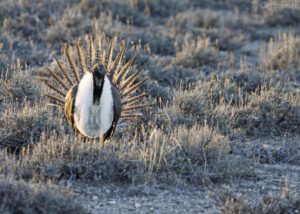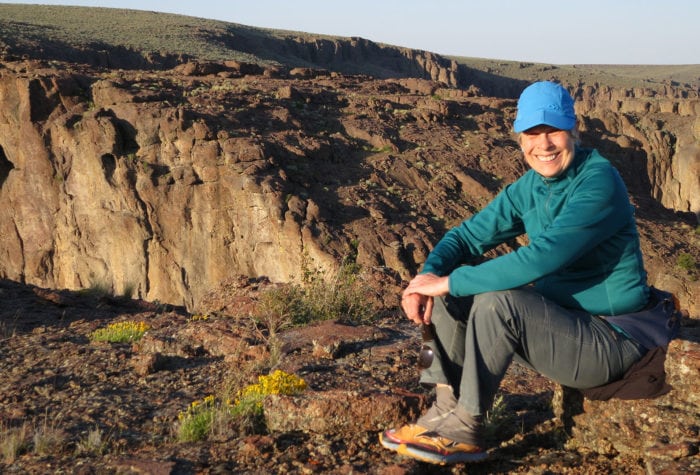Author: Mark Salvo | Published: October 10, 2024 | Category: Deep Dive
Something must be done, and quickly.
Climate change is an existential threat to Oregon’s high desert.
We must immediately address the causes of climate change by transitioning from fossil fuels to renewable energy.
Oregon’s high desert can and should contribute to developing renewable energy sources, including solar and wind.
This could include locating renewable energy facilities on desert public lands, where appropriate.
Allow me to explain.
* * *
Over the last 25 years, conservationists have watched soberly as climate change ascended the list of perils posed to Oregon’s high desert, joining habitat loss, invasive species and wildfire as leading threats to desert wildlife and wildlands.
In fact, climate change compounds those other dangers by worsening droughts, drying up native plant communities, and rendering landscapes more vulnerable to hotter, larger and more destructive wildfires than would naturally occur. Unfortunately, climate change could have especially acute impacts on southeastern Oregon, which is among the fastest warming regions in the country.
Something must be done, and quickly.

Experts have called for mitigating global warming through a rapid and expansive transformation of our energy sources from fossil fuels to renewable energy. Taking their cue, the Biden administration has prioritized “electrifying” our national economy, with the president issuing a sweeping executive order just a week after entering office.
The vast majority of renewable energy development in the United States is for wind, generated by turbines, and solar, produced from photovoltaic panels. Nearly all renewable energy in our country is developed on land as opposed to the sea.
While smaller sized, “dispersed” renewable energy development, such as roof-top solar panels, should be part of our future energy portfolio, “utility scale” development will also be necessary to achieve renewable energy goals. Although large, utility-scale solar and wind energy development would only comprise a tiny percentage of land area in the United States, individual projects can still cover thousands of acres, with potential impacts on wildlife, wildlands, cultural resources and other values.
Utility-scale solar and wind energy facilities have been developed on public lands in other states, but never in Oregon. In fact, ONDA and partners successfully opposed potential construction of as many as 69 wind turbines on top of Steens Mountain a decade ago. The project was proposed on private lands on the summit of Steens, but the transmission lines needed to carry away the generated electricity would have crossed over the Congressionally protected Steens Mountain Cooperative Management and Protection Area, causing unacceptable impacts to wildlife, wildlands, and recreation.

Wishing to avoid future disputes over other poorly planned projects, ONDA published a series of reports on smart renewable energy siting in Oregon’s high desert, culminating in a major guidance document published in 2023, “Siting Renewable Energy in Oregon: Voluntary Guidelines Developed Through Outreach and Engagement.” Prepared with leading partners in Oregon and Washington, D.C., the new guidance recommends how developers and permitting jurisdictions can involve stakeholders in project decision-making to avoid and minimize impacts to conservation, cultural, historical and recreational values and ensure development benefits local communities.
The intense, two-year, community-driven process used to craft the guidelines prepared us for what came next. Acting on President Biden’s order, the Bureau of Land Management—for the first time ever—drafted a plan identifying a fraction of public lands in Oregon that may be appropriate for renewable energy development. We coordinated with allies and agencies to submit comprehensive analyses and recommendations on the proposal to shape a final plan that is best suited to Oregon’s high desert. Importantly, we also accepted that some renewable energy development on desert public lands may be necessary to achieve state, national and even international climate change goals.

The BLM’s new, desert-wide direction would put an end to increasing numbers of ill-considered, wildcat development proposals rumored in southeastern Oregon. Under the proposed plan, the agency would only consider applications for development on public lands already identified as “available” for renewable energy siting. All other public lands would be off limits, without exception.
We welcome this clear, unmistakable direction for locating renewable energy production on public lands, including for how it might encourage development on private lands where historic land conversion has already eliminated native habitats and landowners would like to diversify by developing renewable energy resources.
Once the federal solar energy plan is completed, we anticipate that the BLM will next plan for wind energy development on Oregon’s public lands. We look forward to our continued engagement in these efforts as a critical step toward protecting Oregon’s high desert from climate change.
***
ONDA is at the forefront of efforts to combat climate change in Oregon’s high desert. Propelled by our unwavering community of desert advocates, ONDA’s comprehensive approach includes thoughtful engagement in renewable energy policymaking, protecting large, connected, resilient landscapes, implementing innovative watershed restoration projects and more. Our actions support healthy and vibrant high desert lands, waters, wildlife and communities so that we all may benefit from this special place, now and forever.

